A Comprehensive Report on Nuclear Fission in the United States
VerifiedAdded on 2021/05/27
|18
|6177
|43
Report
AI Summary
This report provides a comprehensive overview of nuclear fission technology in the United States. It begins with an executive summary highlighting the technology's penetration, its role in energy generation, and the impact of accidents on safety standards. The report delves into the current state of nuclear power globally and within the US, discussing the history, technical developments, and policy framework. It examines the impact of nuclear power on the energy system, technical innovations in reactor design, and regulatory aspects. The report also addresses the barriers and opportunities associated with nuclear power, offering a personal perspective on the technology's future and concluding with key findings and references. This student report offers a detailed analysis of nuclear fission's role in the US energy landscape.
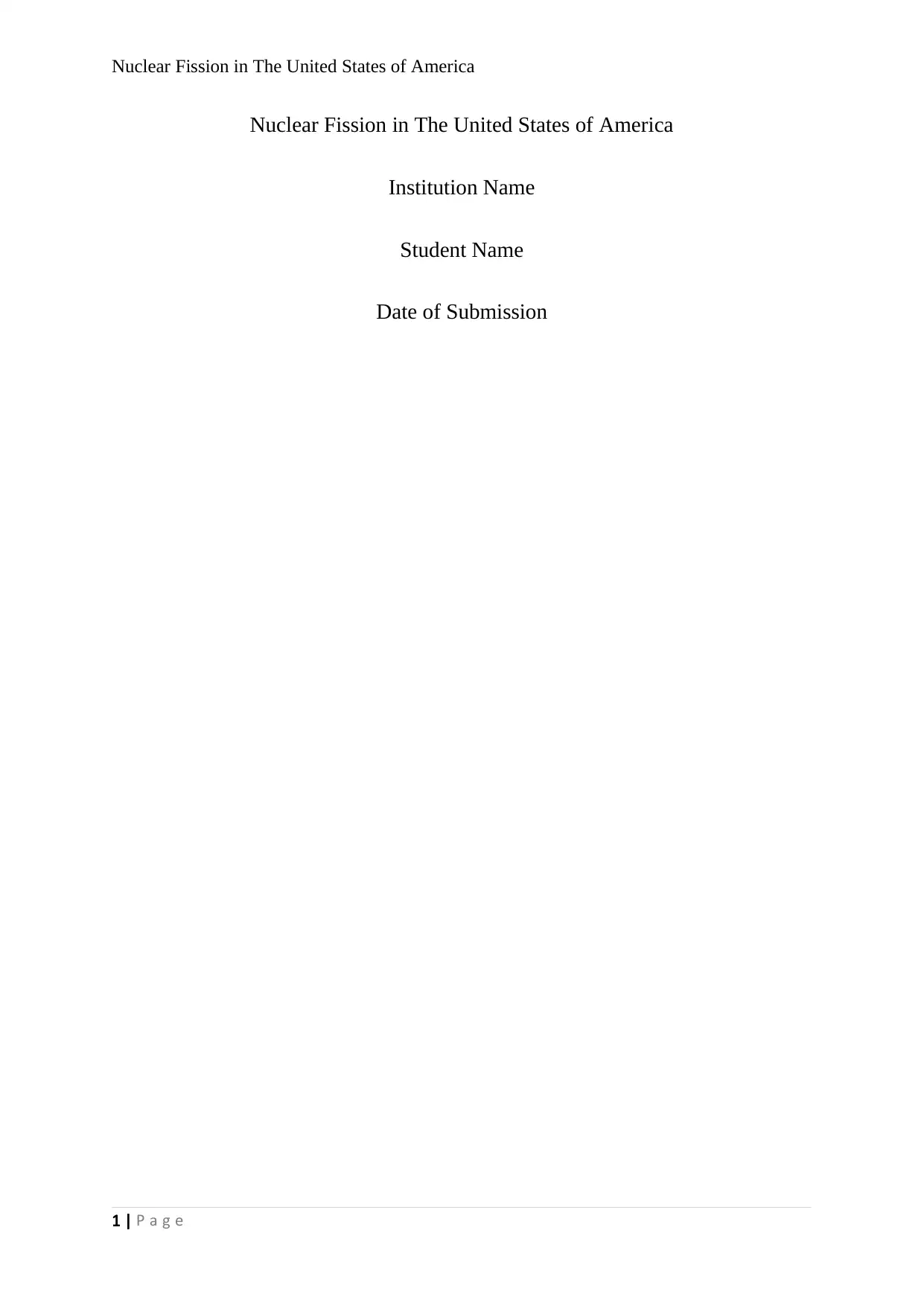
Nuclear Fission in The United States of America
Nuclear Fission in The United States of America
Institution Name
Student Name
Date of Submission
1 | P a g e
Nuclear Fission in The United States of America
Institution Name
Student Name
Date of Submission
1 | P a g e
Paraphrase This Document
Need a fresh take? Get an instant paraphrase of this document with our AI Paraphraser
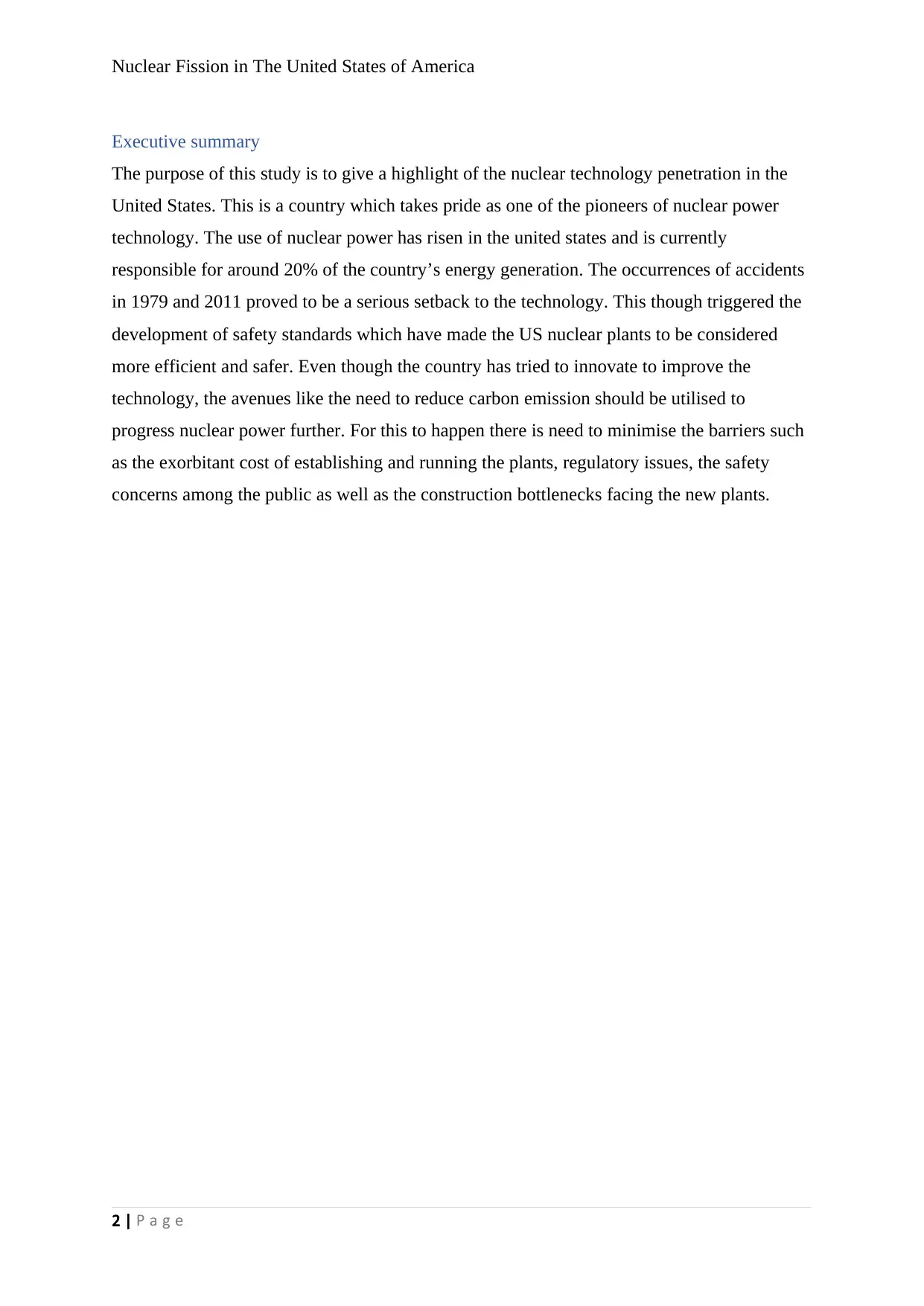
Nuclear Fission in The United States of America
Executive summary
The purpose of this study is to give a highlight of the nuclear technology penetration in the
United States. This is a country which takes pride as one of the pioneers of nuclear power
technology. The use of nuclear power has risen in the united states and is currently
responsible for around 20% of the country’s energy generation. The occurrences of accidents
in 1979 and 2011 proved to be a serious setback to the technology. This though triggered the
development of safety standards which have made the US nuclear plants to be considered
more efficient and safer. Even though the country has tried to innovate to improve the
technology, the avenues like the need to reduce carbon emission should be utilised to
progress nuclear power further. For this to happen there is need to minimise the barriers such
as the exorbitant cost of establishing and running the plants, regulatory issues, the safety
concerns among the public as well as the construction bottlenecks facing the new plants.
2 | P a g e
Executive summary
The purpose of this study is to give a highlight of the nuclear technology penetration in the
United States. This is a country which takes pride as one of the pioneers of nuclear power
technology. The use of nuclear power has risen in the united states and is currently
responsible for around 20% of the country’s energy generation. The occurrences of accidents
in 1979 and 2011 proved to be a serious setback to the technology. This though triggered the
development of safety standards which have made the US nuclear plants to be considered
more efficient and safer. Even though the country has tried to innovate to improve the
technology, the avenues like the need to reduce carbon emission should be utilised to
progress nuclear power further. For this to happen there is need to minimise the barriers such
as the exorbitant cost of establishing and running the plants, regulatory issues, the safety
concerns among the public as well as the construction bottlenecks facing the new plants.
2 | P a g e
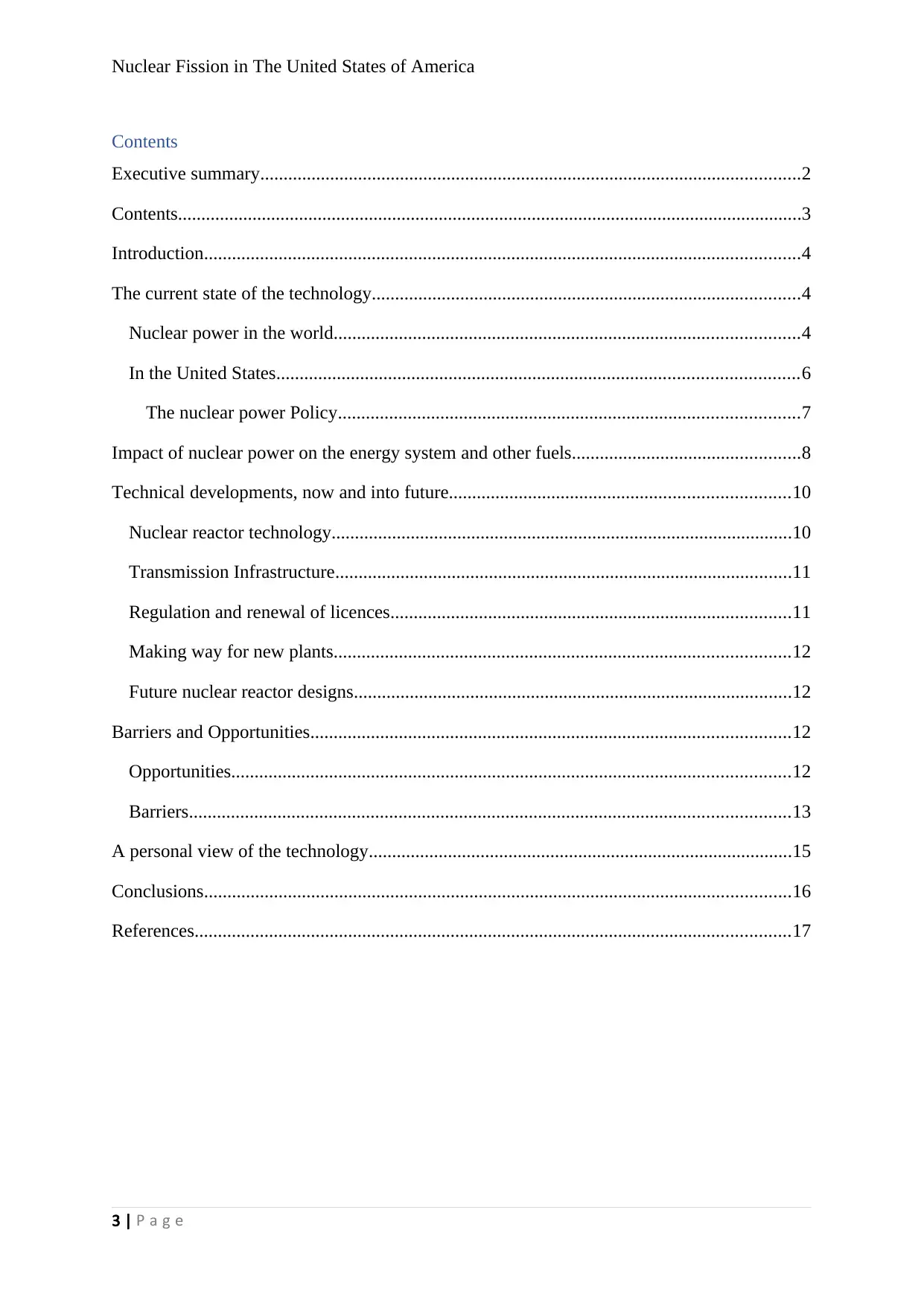
Nuclear Fission in The United States of America
Contents
Executive summary....................................................................................................................2
Contents......................................................................................................................................3
Introduction................................................................................................................................4
The current state of the technology............................................................................................4
Nuclear power in the world....................................................................................................4
In the United States................................................................................................................6
The nuclear power Policy...................................................................................................7
Impact of nuclear power on the energy system and other fuels.................................................8
Technical developments, now and into future.........................................................................10
Nuclear reactor technology...................................................................................................10
Transmission Infrastructure..................................................................................................11
Regulation and renewal of licences......................................................................................11
Making way for new plants..................................................................................................12
Future nuclear reactor designs..............................................................................................12
Barriers and Opportunities.......................................................................................................12
Opportunities........................................................................................................................12
Barriers.................................................................................................................................13
A personal view of the technology...........................................................................................15
Conclusions..............................................................................................................................16
References................................................................................................................................17
3 | P a g e
Contents
Executive summary....................................................................................................................2
Contents......................................................................................................................................3
Introduction................................................................................................................................4
The current state of the technology............................................................................................4
Nuclear power in the world....................................................................................................4
In the United States................................................................................................................6
The nuclear power Policy...................................................................................................7
Impact of nuclear power on the energy system and other fuels.................................................8
Technical developments, now and into future.........................................................................10
Nuclear reactor technology...................................................................................................10
Transmission Infrastructure..................................................................................................11
Regulation and renewal of licences......................................................................................11
Making way for new plants..................................................................................................12
Future nuclear reactor designs..............................................................................................12
Barriers and Opportunities.......................................................................................................12
Opportunities........................................................................................................................12
Barriers.................................................................................................................................13
A personal view of the technology...........................................................................................15
Conclusions..............................................................................................................................16
References................................................................................................................................17
3 | P a g e
⊘ This is a preview!⊘
Do you want full access?
Subscribe today to unlock all pages.

Trusted by 1+ million students worldwide

Nuclear Fission in The United States of America
Introduction
The overreliance on carbon compounds for power generation has caused the globe a lot of
harm. The current climate change menace being the major setback. With the need to develop
a sustainable energy sector the world agrees that industrialised nations need to take the lead
in eradicating the use of fossil fuels (The National Academies Press, 2011). The US is one
such country which has shown a lot of passion in campaigning against the use of carbon
fuels. As a way of offering its citizens an alternative energy source the country has constantly
improved its investment in the nuclear sector.
The United States is one of the countries which pioneered the development of the nuclear
energy. This happened in the 1940s when the technology was used to create atomic bombs
used in the world war II. The use of nuclear technology has since been revolutionised and
most of the countries have now adopted its use for generation of clean energy.
In this research will examine the development of the nuclear technology in the United States.
This will entail a review of the current state of the technology, the technical development that
it has undergone, avenues for further development as well as some of the barriers which have
hindered the sector’s competitiveness. Afterward the research will be close by a presentation
of my personal view regarding the use of nuclear power based on existing evidence.
The current state of the technology
Nuclear power in the world
The nuclear fission technology makes use of the energy from splitting atoms of unique
elements. The technology first come into the limelight in 1940. The technology was pursued
during the second world war, at that time it was only limited to the development of atomic
bombs (Helge, 1999). It was until 1950 that focus turned to applying the nuclear technology
especially nuclear fission to produce energy. This marks the beginning of the peaceful use of
nuclear power innovation (Schneider & Froggatt, 2012).
Apparently, the use of civil nuclear power has been there for 1700 years, within this time its
application has spread with around 30 countries having embraced its use globally. Through
the regional transmission grids several many other nations are dependent on a section of the
nuclear-generated power. For example, Denmark and Italy obtain 10% of their electricity
from the importation of nuclear power (Jim, 1982).
4 | P a g e
Introduction
The overreliance on carbon compounds for power generation has caused the globe a lot of
harm. The current climate change menace being the major setback. With the need to develop
a sustainable energy sector the world agrees that industrialised nations need to take the lead
in eradicating the use of fossil fuels (The National Academies Press, 2011). The US is one
such country which has shown a lot of passion in campaigning against the use of carbon
fuels. As a way of offering its citizens an alternative energy source the country has constantly
improved its investment in the nuclear sector.
The United States is one of the countries which pioneered the development of the nuclear
energy. This happened in the 1940s when the technology was used to create atomic bombs
used in the world war II. The use of nuclear technology has since been revolutionised and
most of the countries have now adopted its use for generation of clean energy.
In this research will examine the development of the nuclear technology in the United States.
This will entail a review of the current state of the technology, the technical development that
it has undergone, avenues for further development as well as some of the barriers which have
hindered the sector’s competitiveness. Afterward the research will be close by a presentation
of my personal view regarding the use of nuclear power based on existing evidence.
The current state of the technology
Nuclear power in the world
The nuclear fission technology makes use of the energy from splitting atoms of unique
elements. The technology first come into the limelight in 1940. The technology was pursued
during the second world war, at that time it was only limited to the development of atomic
bombs (Helge, 1999). It was until 1950 that focus turned to applying the nuclear technology
especially nuclear fission to produce energy. This marks the beginning of the peaceful use of
nuclear power innovation (Schneider & Froggatt, 2012).
Apparently, the use of civil nuclear power has been there for 1700 years, within this time its
application has spread with around 30 countries having embraced its use globally. Through
the regional transmission grids several many other nations are dependent on a section of the
nuclear-generated power. For example, Denmark and Italy obtain 10% of their electricity
from the importation of nuclear power (Jim, 1982).
4 | P a g e
Paraphrase This Document
Need a fresh take? Get an instant paraphrase of this document with our AI Paraphraser
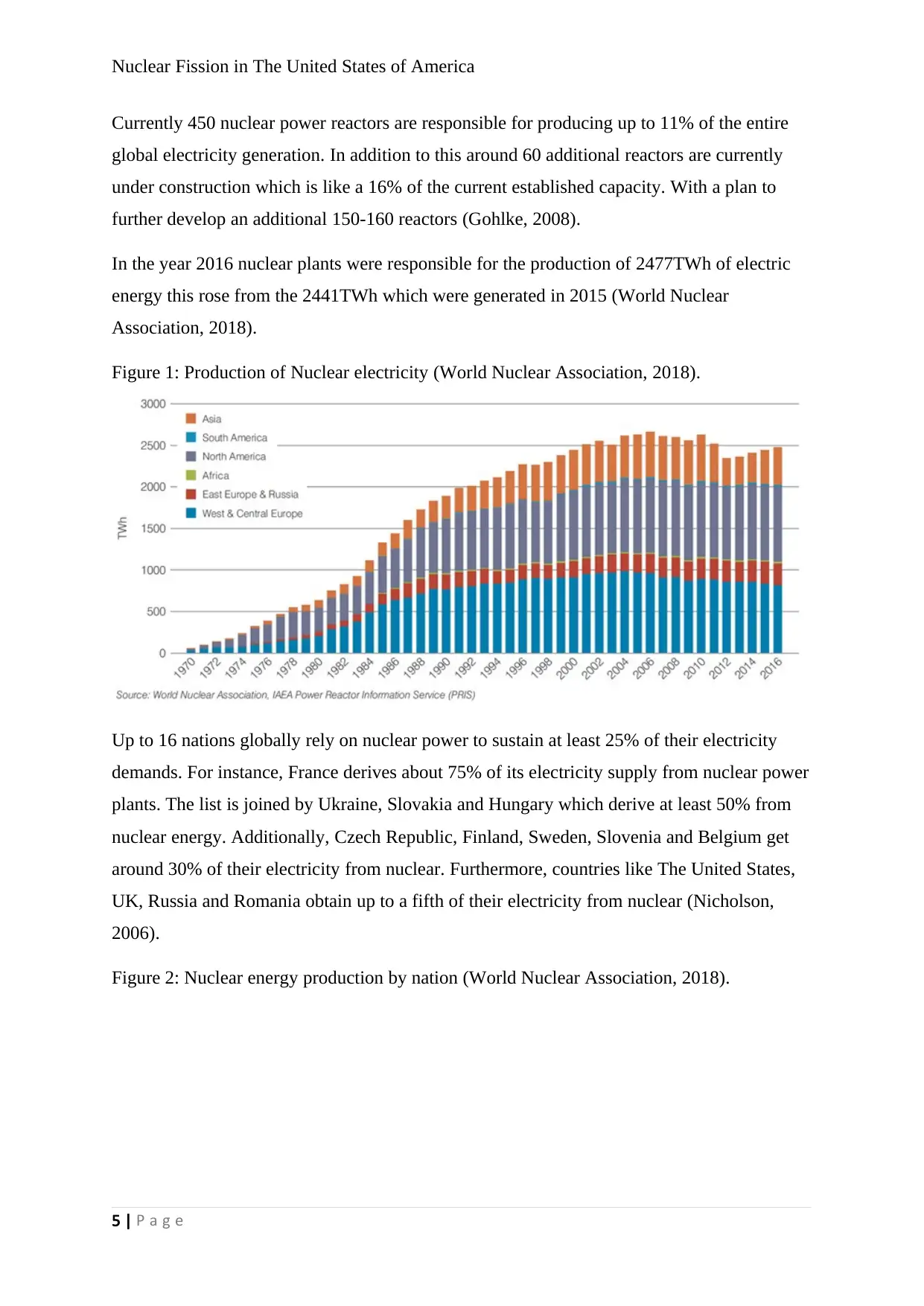
Nuclear Fission in The United States of America
Currently 450 nuclear power reactors are responsible for producing up to 11% of the entire
global electricity generation. In addition to this around 60 additional reactors are currently
under construction which is like a 16% of the current established capacity. With a plan to
further develop an additional 150-160 reactors (Gohlke, 2008).
In the year 2016 nuclear plants were responsible for the production of 2477TWh of electric
energy this rose from the 2441TWh which were generated in 2015 (World Nuclear
Association, 2018).
Figure 1: Production of Nuclear electricity (World Nuclear Association, 2018).
Up to 16 nations globally rely on nuclear power to sustain at least 25% of their electricity
demands. For instance, France derives about 75% of its electricity supply from nuclear power
plants. The list is joined by Ukraine, Slovakia and Hungary which derive at least 50% from
nuclear energy. Additionally, Czech Republic, Finland, Sweden, Slovenia and Belgium get
around 30% of their electricity from nuclear. Furthermore, countries like The United States,
UK, Russia and Romania obtain up to a fifth of their electricity from nuclear (Nicholson,
2006).
Figure 2: Nuclear energy production by nation (World Nuclear Association, 2018).
5 | P a g e
Currently 450 nuclear power reactors are responsible for producing up to 11% of the entire
global electricity generation. In addition to this around 60 additional reactors are currently
under construction which is like a 16% of the current established capacity. With a plan to
further develop an additional 150-160 reactors (Gohlke, 2008).
In the year 2016 nuclear plants were responsible for the production of 2477TWh of electric
energy this rose from the 2441TWh which were generated in 2015 (World Nuclear
Association, 2018).
Figure 1: Production of Nuclear electricity (World Nuclear Association, 2018).
Up to 16 nations globally rely on nuclear power to sustain at least 25% of their electricity
demands. For instance, France derives about 75% of its electricity supply from nuclear power
plants. The list is joined by Ukraine, Slovakia and Hungary which derive at least 50% from
nuclear energy. Additionally, Czech Republic, Finland, Sweden, Slovenia and Belgium get
around 30% of their electricity from nuclear. Furthermore, countries like The United States,
UK, Russia and Romania obtain up to a fifth of their electricity from nuclear (Nicholson,
2006).
Figure 2: Nuclear energy production by nation (World Nuclear Association, 2018).
5 | P a g e

Nuclear Fission in The United States of America
As the globe prepares to get rid of the dependency on the fossil fuels there is an urgent need
to construct new generating capacities. This calls for further innovation into the nuclear
technology. By 2015 energy generated from fossil fuels contributed up to 66% of the global
energy demand. This has withstood the pressure from environmentalist and organizations
concerned with climate change to expand the use of renewable energy sources. From 2005
the use of fossil fuels has virtually remained unchanged; this form of trend should be
worrying if the correlation of carbon emission and the climate change disaster is something to
go by (Bodansky, 2004).
In the United States
The United is the pioneer of nuclear technology. The first fully commercial pressurised water
reactor (PWR) was developed by Westinghouse. This reactor had a capacity of 250MWe. On
the other hand, the boiling water reactor (BWR) was designed by Argonne National
Laboratory with the first commercial plant being developed by General Electric in the 1960s.
6 | P a g e
As the globe prepares to get rid of the dependency on the fossil fuels there is an urgent need
to construct new generating capacities. This calls for further innovation into the nuclear
technology. By 2015 energy generated from fossil fuels contributed up to 66% of the global
energy demand. This has withstood the pressure from environmentalist and organizations
concerned with climate change to expand the use of renewable energy sources. From 2005
the use of fossil fuels has virtually remained unchanged; this form of trend should be
worrying if the correlation of carbon emission and the climate change disaster is something to
go by (Bodansky, 2004).
In the United States
The United is the pioneer of nuclear technology. The first fully commercial pressurised water
reactor (PWR) was developed by Westinghouse. This reactor had a capacity of 250MWe. On
the other hand, the boiling water reactor (BWR) was designed by Argonne National
Laboratory with the first commercial plant being developed by General Electric in the 1960s.
6 | P a g e
⊘ This is a preview!⊘
Do you want full access?
Subscribe today to unlock all pages.

Trusted by 1+ million students worldwide
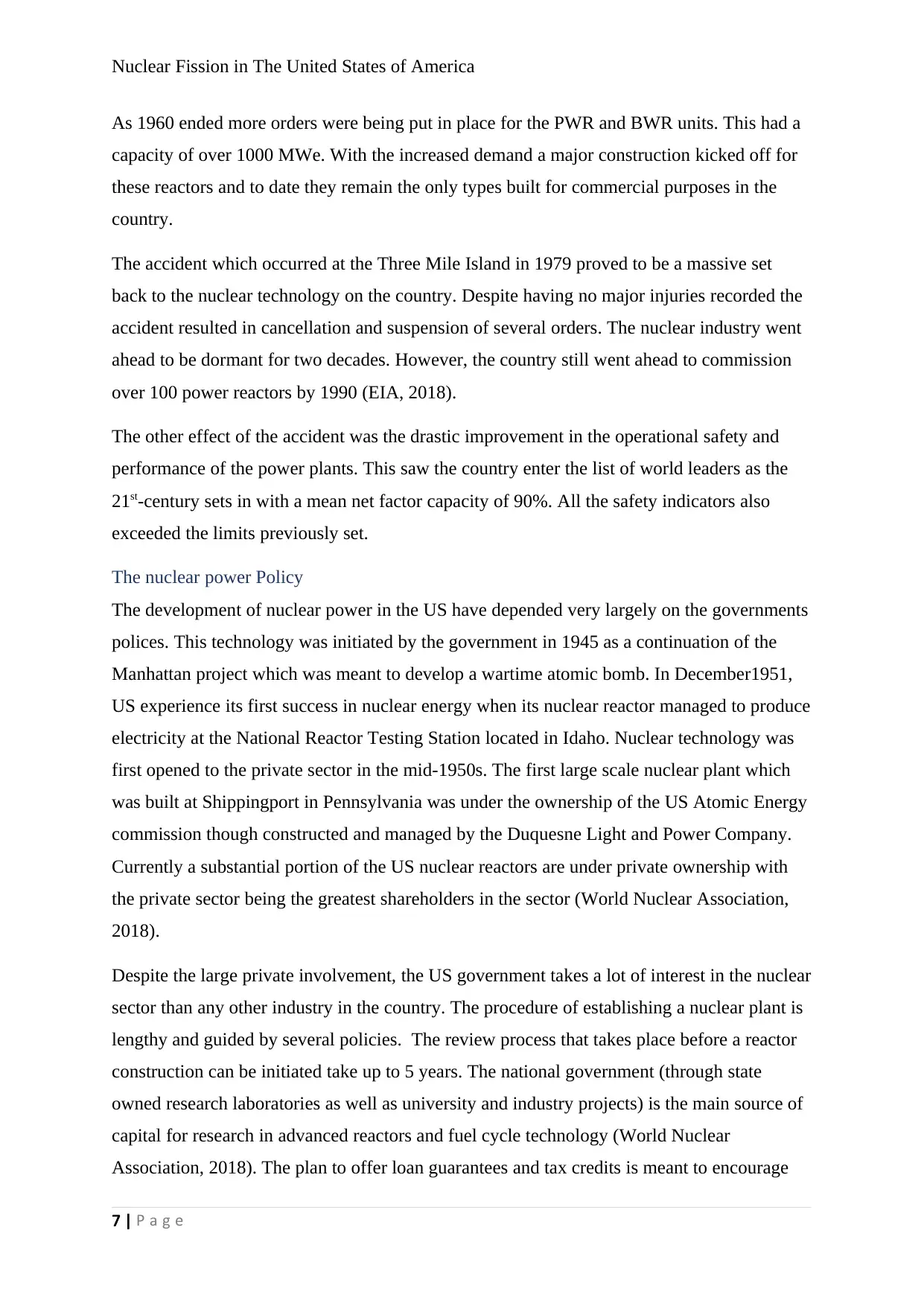
Nuclear Fission in The United States of America
As 1960 ended more orders were being put in place for the PWR and BWR units. This had a
capacity of over 1000 MWe. With the increased demand a major construction kicked off for
these reactors and to date they remain the only types built for commercial purposes in the
country.
The accident which occurred at the Three Mile Island in 1979 proved to be a massive set
back to the nuclear technology on the country. Despite having no major injuries recorded the
accident resulted in cancellation and suspension of several orders. The nuclear industry went
ahead to be dormant for two decades. However, the country still went ahead to commission
over 100 power reactors by 1990 (EIA, 2018).
The other effect of the accident was the drastic improvement in the operational safety and
performance of the power plants. This saw the country enter the list of world leaders as the
21st-century sets in with a mean net factor capacity of 90%. All the safety indicators also
exceeded the limits previously set.
The nuclear power Policy
The development of nuclear power in the US have depended very largely on the governments
polices. This technology was initiated by the government in 1945 as a continuation of the
Manhattan project which was meant to develop a wartime atomic bomb. In December1951,
US experience its first success in nuclear energy when its nuclear reactor managed to produce
electricity at the National Reactor Testing Station located in Idaho. Nuclear technology was
first opened to the private sector in the mid-1950s. The first large scale nuclear plant which
was built at Shippingport in Pennsylvania was under the ownership of the US Atomic Energy
commission though constructed and managed by the Duquesne Light and Power Company.
Currently a substantial portion of the US nuclear reactors are under private ownership with
the private sector being the greatest shareholders in the sector (World Nuclear Association,
2018).
Despite the large private involvement, the US government takes a lot of interest in the nuclear
sector than any other industry in the country. The procedure of establishing a nuclear plant is
lengthy and guided by several policies. The review process that takes place before a reactor
construction can be initiated take up to 5 years. The national government (through state
owned research laboratories as well as university and industry projects) is the main source of
capital for research in advanced reactors and fuel cycle technology (World Nuclear
Association, 2018). The plan to offer loan guarantees and tax credits is meant to encourage
7 | P a g e
As 1960 ended more orders were being put in place for the PWR and BWR units. This had a
capacity of over 1000 MWe. With the increased demand a major construction kicked off for
these reactors and to date they remain the only types built for commercial purposes in the
country.
The accident which occurred at the Three Mile Island in 1979 proved to be a massive set
back to the nuclear technology on the country. Despite having no major injuries recorded the
accident resulted in cancellation and suspension of several orders. The nuclear industry went
ahead to be dormant for two decades. However, the country still went ahead to commission
over 100 power reactors by 1990 (EIA, 2018).
The other effect of the accident was the drastic improvement in the operational safety and
performance of the power plants. This saw the country enter the list of world leaders as the
21st-century sets in with a mean net factor capacity of 90%. All the safety indicators also
exceeded the limits previously set.
The nuclear power Policy
The development of nuclear power in the US have depended very largely on the governments
polices. This technology was initiated by the government in 1945 as a continuation of the
Manhattan project which was meant to develop a wartime atomic bomb. In December1951,
US experience its first success in nuclear energy when its nuclear reactor managed to produce
electricity at the National Reactor Testing Station located in Idaho. Nuclear technology was
first opened to the private sector in the mid-1950s. The first large scale nuclear plant which
was built at Shippingport in Pennsylvania was under the ownership of the US Atomic Energy
commission though constructed and managed by the Duquesne Light and Power Company.
Currently a substantial portion of the US nuclear reactors are under private ownership with
the private sector being the greatest shareholders in the sector (World Nuclear Association,
2018).
Despite the large private involvement, the US government takes a lot of interest in the nuclear
sector than any other industry in the country. The procedure of establishing a nuclear plant is
lengthy and guided by several policies. The review process that takes place before a reactor
construction can be initiated take up to 5 years. The national government (through state
owned research laboratories as well as university and industry projects) is the main source of
capital for research in advanced reactors and fuel cycle technology (World Nuclear
Association, 2018). The plan to offer loan guarantees and tax credits is meant to encourage
7 | P a g e
Paraphrase This Document
Need a fresh take? Get an instant paraphrase of this document with our AI Paraphraser

Nuclear Fission in The United States of America
more investments meant for building new nuclear plants. The interrelation between the US
energy policy with the foreign trade and defence policy have seen the sectors work in
collaboration to mitigate climate change issues as well as address the issue of nuclear
weapons.
By late 2013 Nuclear Regulatory Commission (NRC) was undertaking a review of 9
applications for combined construction and operating licenses which were meant to pave way
for the construction of 14 new nuclear reactors. Also, under review were certification
application for the design of new reactors of type EPR, ESBWR and APWR.
Another major player in the nuclear sector is the state and local governments. There
contribution’s come in defining the framework and economics of the industry. For instance,
the deregulation of the electricity prices in a section of states in the country in the 1990s saw
the states have a larger concentration of nuclear plants. Furthermore, a referendum carried out
in 1976 in California restricted construction of new nuclear plants in the state, this prohibition
exists to date. The administration of Barack Obama had to abandon plans for the construction
of a 70000-tonne geological repository in Nevada in 2009 due to the state government
opposition. This repository was meant for disposal of high-level nuclear waste that had
accumulated in several reactor sites in the country (World Nuclear Association, 2018).
Impact of nuclear power on the energy system and other fuels
In the year 2016 the total energy generated by the United States was 4079TWh net. This was
distributed as follows; 34% come from gas, 30% from the coal-fired plants, 19.7% from
nuclear while the remaining 16% were derived from hydro-electric, wind, and other
renewable sources. The nation’s annual energy demand is projected to reach 5000 billion
kWh by 2030. Considering the global plans to eradicate the carbon fuels there is a possibility
of a huge void between the energy demand and supply in the near future. This calls for
speedy development of the alternative energy, sources nuclear being one of them.
The role of nuclear power in the current US energy mix is massive, apparently the country
has 99 operating nuclear reactors spread across 30 States. These reactors are under different
power firms and managed to generate 805TWh of energy in 2016. From 2001 the nuclear
plants have managed to attain a mean capacity factor of above 90%. This means they can
generate 807 TWh annually which contribute around 20% of the total electricity produced in
the country. The mean capacity factor rose from 50% in the 1970s to hit 70% by 1991. In the
year 2002 the value surpassed 90% and have since leveled up at that point. The nuclear
8 | P a g e
more investments meant for building new nuclear plants. The interrelation between the US
energy policy with the foreign trade and defence policy have seen the sectors work in
collaboration to mitigate climate change issues as well as address the issue of nuclear
weapons.
By late 2013 Nuclear Regulatory Commission (NRC) was undertaking a review of 9
applications for combined construction and operating licenses which were meant to pave way
for the construction of 14 new nuclear reactors. Also, under review were certification
application for the design of new reactors of type EPR, ESBWR and APWR.
Another major player in the nuclear sector is the state and local governments. There
contribution’s come in defining the framework and economics of the industry. For instance,
the deregulation of the electricity prices in a section of states in the country in the 1990s saw
the states have a larger concentration of nuclear plants. Furthermore, a referendum carried out
in 1976 in California restricted construction of new nuclear plants in the state, this prohibition
exists to date. The administration of Barack Obama had to abandon plans for the construction
of a 70000-tonne geological repository in Nevada in 2009 due to the state government
opposition. This repository was meant for disposal of high-level nuclear waste that had
accumulated in several reactor sites in the country (World Nuclear Association, 2018).
Impact of nuclear power on the energy system and other fuels
In the year 2016 the total energy generated by the United States was 4079TWh net. This was
distributed as follows; 34% come from gas, 30% from the coal-fired plants, 19.7% from
nuclear while the remaining 16% were derived from hydro-electric, wind, and other
renewable sources. The nation’s annual energy demand is projected to reach 5000 billion
kWh by 2030. Considering the global plans to eradicate the carbon fuels there is a possibility
of a huge void between the energy demand and supply in the near future. This calls for
speedy development of the alternative energy, sources nuclear being one of them.
The role of nuclear power in the current US energy mix is massive, apparently the country
has 99 operating nuclear reactors spread across 30 States. These reactors are under different
power firms and managed to generate 805TWh of energy in 2016. From 2001 the nuclear
plants have managed to attain a mean capacity factor of above 90%. This means they can
generate 807 TWh annually which contribute around 20% of the total electricity produced in
the country. The mean capacity factor rose from 50% in the 1970s to hit 70% by 1991. In the
year 2002 the value surpassed 90% and have since leveled up at that point. The nuclear
8 | P a g e
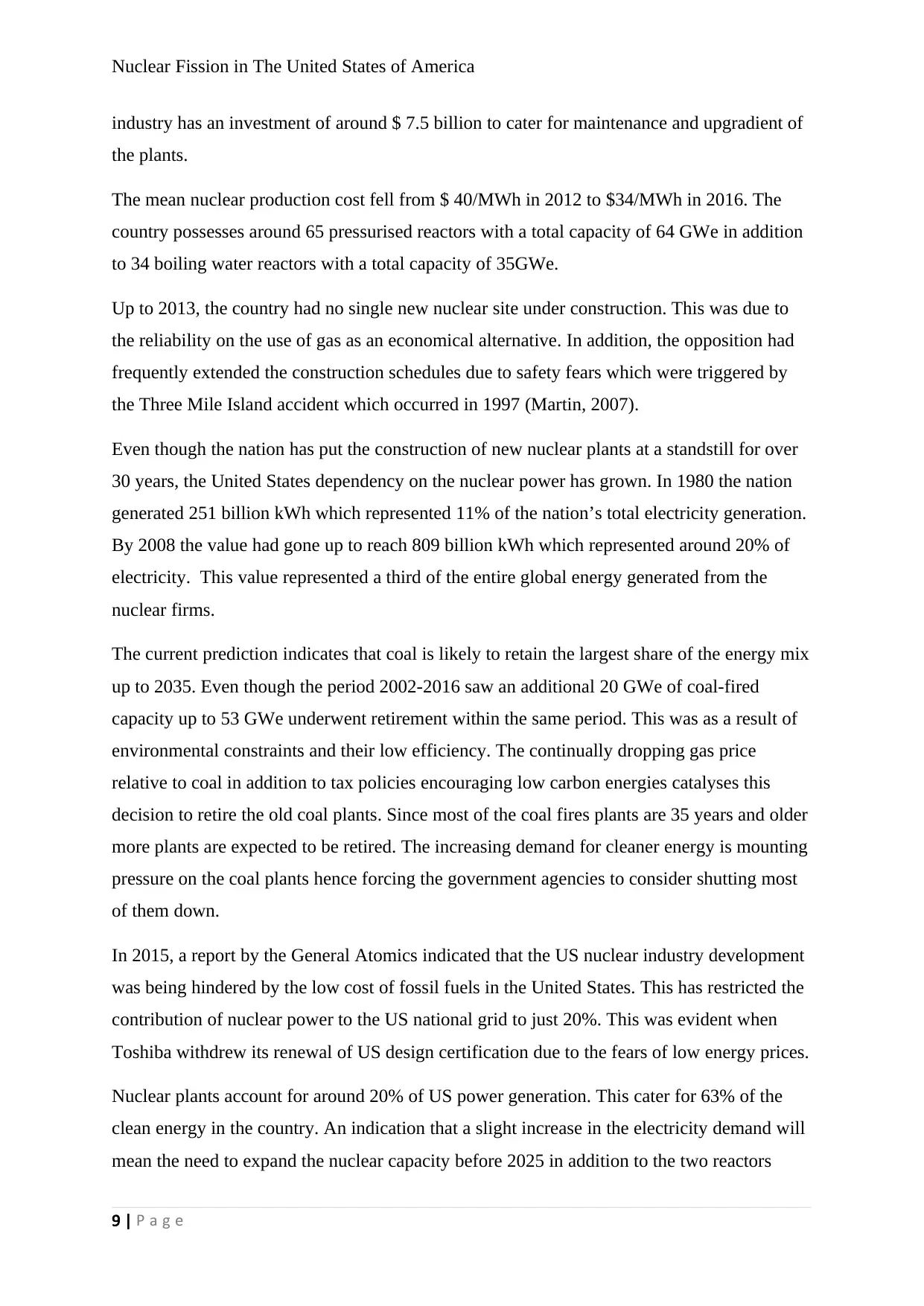
Nuclear Fission in The United States of America
industry has an investment of around $ 7.5 billion to cater for maintenance and upgradient of
the plants.
The mean nuclear production cost fell from $ 40/MWh in 2012 to $34/MWh in 2016. The
country possesses around 65 pressurised reactors with a total capacity of 64 GWe in addition
to 34 boiling water reactors with a total capacity of 35GWe.
Up to 2013, the country had no single new nuclear site under construction. This was due to
the reliability on the use of gas as an economical alternative. In addition, the opposition had
frequently extended the construction schedules due to safety fears which were triggered by
the Three Mile Island accident which occurred in 1997 (Martin, 2007).
Even though the nation has put the construction of new nuclear plants at a standstill for over
30 years, the United States dependency on the nuclear power has grown. In 1980 the nation
generated 251 billion kWh which represented 11% of the nation’s total electricity generation.
By 2008 the value had gone up to reach 809 billion kWh which represented around 20% of
electricity. This value represented a third of the entire global energy generated from the
nuclear firms.
The current prediction indicates that coal is likely to retain the largest share of the energy mix
up to 2035. Even though the period 2002-2016 saw an additional 20 GWe of coal-fired
capacity up to 53 GWe underwent retirement within the same period. This was as a result of
environmental constraints and their low efficiency. The continually dropping gas price
relative to coal in addition to tax policies encouraging low carbon energies catalyses this
decision to retire the old coal plants. Since most of the coal fires plants are 35 years and older
more plants are expected to be retired. The increasing demand for cleaner energy is mounting
pressure on the coal plants hence forcing the government agencies to consider shutting most
of them down.
In 2015, a report by the General Atomics indicated that the US nuclear industry development
was being hindered by the low cost of fossil fuels in the United States. This has restricted the
contribution of nuclear power to the US national grid to just 20%. This was evident when
Toshiba withdrew its renewal of US design certification due to the fears of low energy prices.
Nuclear plants account for around 20% of US power generation. This cater for 63% of the
clean energy in the country. An indication that a slight increase in the electricity demand will
mean the need to expand the nuclear capacity before 2025 in addition to the two reactors
9 | P a g e
industry has an investment of around $ 7.5 billion to cater for maintenance and upgradient of
the plants.
The mean nuclear production cost fell from $ 40/MWh in 2012 to $34/MWh in 2016. The
country possesses around 65 pressurised reactors with a total capacity of 64 GWe in addition
to 34 boiling water reactors with a total capacity of 35GWe.
Up to 2013, the country had no single new nuclear site under construction. This was due to
the reliability on the use of gas as an economical alternative. In addition, the opposition had
frequently extended the construction schedules due to safety fears which were triggered by
the Three Mile Island accident which occurred in 1997 (Martin, 2007).
Even though the nation has put the construction of new nuclear plants at a standstill for over
30 years, the United States dependency on the nuclear power has grown. In 1980 the nation
generated 251 billion kWh which represented 11% of the nation’s total electricity generation.
By 2008 the value had gone up to reach 809 billion kWh which represented around 20% of
electricity. This value represented a third of the entire global energy generated from the
nuclear firms.
The current prediction indicates that coal is likely to retain the largest share of the energy mix
up to 2035. Even though the period 2002-2016 saw an additional 20 GWe of coal-fired
capacity up to 53 GWe underwent retirement within the same period. This was as a result of
environmental constraints and their low efficiency. The continually dropping gas price
relative to coal in addition to tax policies encouraging low carbon energies catalyses this
decision to retire the old coal plants. Since most of the coal fires plants are 35 years and older
more plants are expected to be retired. The increasing demand for cleaner energy is mounting
pressure on the coal plants hence forcing the government agencies to consider shutting most
of them down.
In 2015, a report by the General Atomics indicated that the US nuclear industry development
was being hindered by the low cost of fossil fuels in the United States. This has restricted the
contribution of nuclear power to the US national grid to just 20%. This was evident when
Toshiba withdrew its renewal of US design certification due to the fears of low energy prices.
Nuclear plants account for around 20% of US power generation. This cater for 63% of the
clean energy in the country. An indication that a slight increase in the electricity demand will
mean the need to expand the nuclear capacity before 2025 in addition to the two reactors
9 | P a g e
⊘ This is a preview!⊘
Do you want full access?
Subscribe today to unlock all pages.

Trusted by 1+ million students worldwide
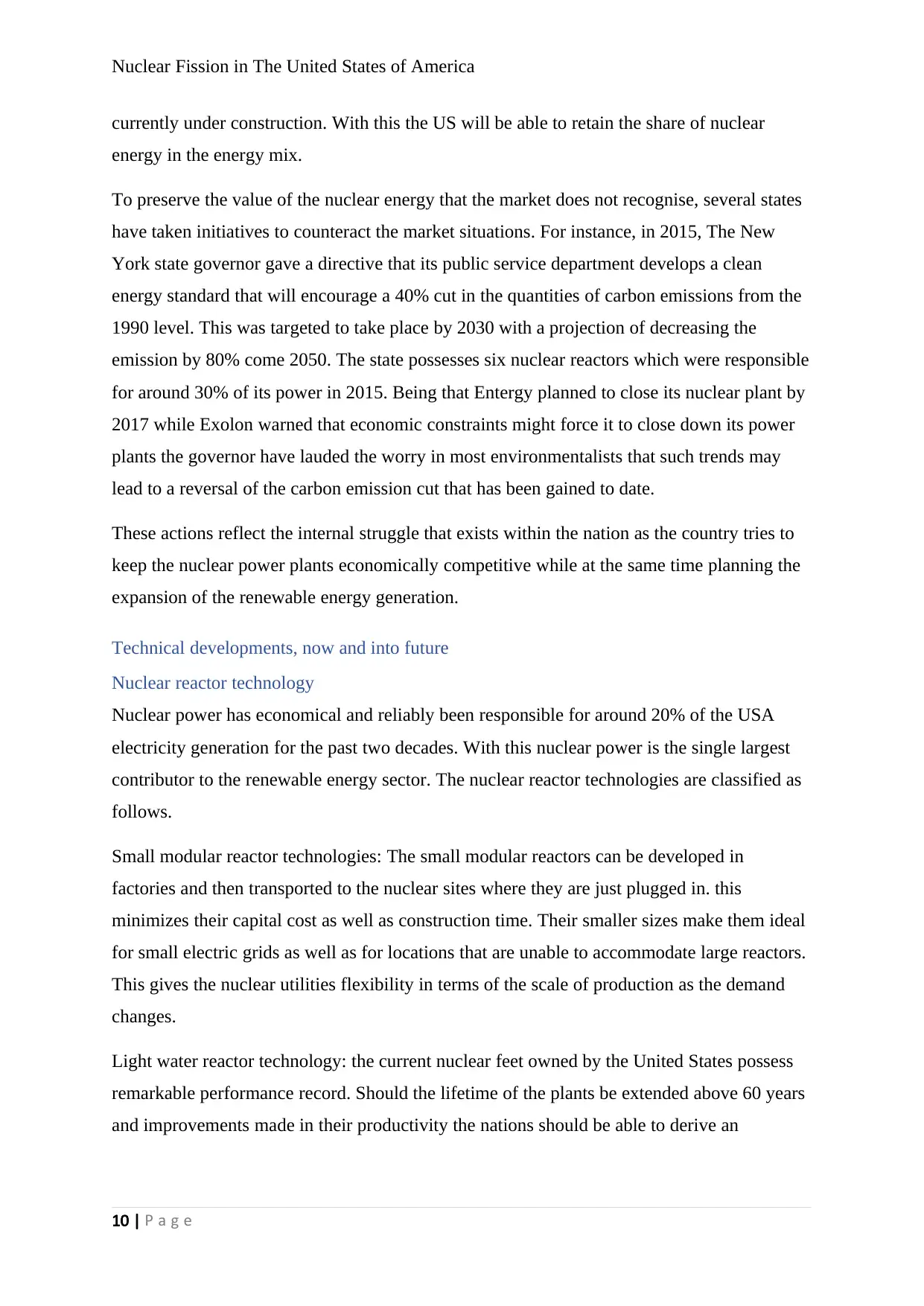
Nuclear Fission in The United States of America
currently under construction. With this the US will be able to retain the share of nuclear
energy in the energy mix.
To preserve the value of the nuclear energy that the market does not recognise, several states
have taken initiatives to counteract the market situations. For instance, in 2015, The New
York state governor gave a directive that its public service department develops a clean
energy standard that will encourage a 40% cut in the quantities of carbon emissions from the
1990 level. This was targeted to take place by 2030 with a projection of decreasing the
emission by 80% come 2050. The state possesses six nuclear reactors which were responsible
for around 30% of its power in 2015. Being that Entergy planned to close its nuclear plant by
2017 while Exolon warned that economic constraints might force it to close down its power
plants the governor have lauded the worry in most environmentalists that such trends may
lead to a reversal of the carbon emission cut that has been gained to date.
These actions reflect the internal struggle that exists within the nation as the country tries to
keep the nuclear power plants economically competitive while at the same time planning the
expansion of the renewable energy generation.
Technical developments, now and into future
Nuclear reactor technology
Nuclear power has economical and reliably been responsible for around 20% of the USA
electricity generation for the past two decades. With this nuclear power is the single largest
contributor to the renewable energy sector. The nuclear reactor technologies are classified as
follows.
Small modular reactor technologies: The small modular reactors can be developed in
factories and then transported to the nuclear sites where they are just plugged in. this
minimizes their capital cost as well as construction time. Their smaller sizes make them ideal
for small electric grids as well as for locations that are unable to accommodate large reactors.
This gives the nuclear utilities flexibility in terms of the scale of production as the demand
changes.
Light water reactor technology: the current nuclear feet owned by the United States possess
remarkable performance record. Should the lifetime of the plants be extended above 60 years
and improvements made in their productivity the nations should be able to derive an
10 | P a g e
currently under construction. With this the US will be able to retain the share of nuclear
energy in the energy mix.
To preserve the value of the nuclear energy that the market does not recognise, several states
have taken initiatives to counteract the market situations. For instance, in 2015, The New
York state governor gave a directive that its public service department develops a clean
energy standard that will encourage a 40% cut in the quantities of carbon emissions from the
1990 level. This was targeted to take place by 2030 with a projection of decreasing the
emission by 80% come 2050. The state possesses six nuclear reactors which were responsible
for around 30% of its power in 2015. Being that Entergy planned to close its nuclear plant by
2017 while Exolon warned that economic constraints might force it to close down its power
plants the governor have lauded the worry in most environmentalists that such trends may
lead to a reversal of the carbon emission cut that has been gained to date.
These actions reflect the internal struggle that exists within the nation as the country tries to
keep the nuclear power plants economically competitive while at the same time planning the
expansion of the renewable energy generation.
Technical developments, now and into future
Nuclear reactor technology
Nuclear power has economical and reliably been responsible for around 20% of the USA
electricity generation for the past two decades. With this nuclear power is the single largest
contributor to the renewable energy sector. The nuclear reactor technologies are classified as
follows.
Small modular reactor technologies: The small modular reactors can be developed in
factories and then transported to the nuclear sites where they are just plugged in. this
minimizes their capital cost as well as construction time. Their smaller sizes make them ideal
for small electric grids as well as for locations that are unable to accommodate large reactors.
This gives the nuclear utilities flexibility in terms of the scale of production as the demand
changes.
Light water reactor technology: the current nuclear feet owned by the United States possess
remarkable performance record. Should the lifetime of the plants be extended above 60 years
and improvements made in their productivity the nations should be able to derive an
10 | P a g e
Paraphrase This Document
Need a fresh take? Get an instant paraphrase of this document with our AI Paraphraser
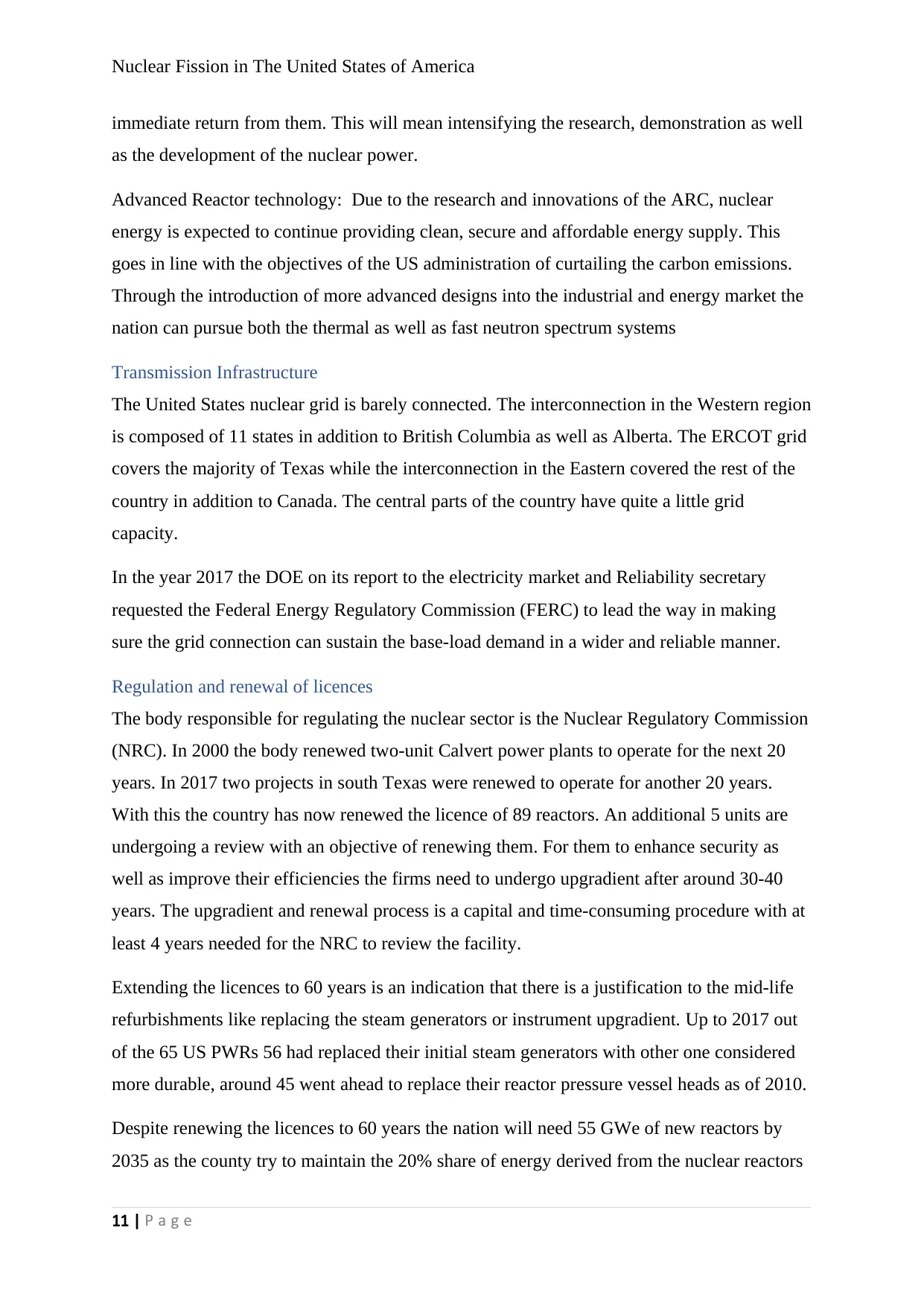
Nuclear Fission in The United States of America
immediate return from them. This will mean intensifying the research, demonstration as well
as the development of the nuclear power.
Advanced Reactor technology: Due to the research and innovations of the ARC, nuclear
energy is expected to continue providing clean, secure and affordable energy supply. This
goes in line with the objectives of the US administration of curtailing the carbon emissions.
Through the introduction of more advanced designs into the industrial and energy market the
nation can pursue both the thermal as well as fast neutron spectrum systems
Transmission Infrastructure
The United States nuclear grid is barely connected. The interconnection in the Western region
is composed of 11 states in addition to British Columbia as well as Alberta. The ERCOT grid
covers the majority of Texas while the interconnection in the Eastern covered the rest of the
country in addition to Canada. The central parts of the country have quite a little grid
capacity.
In the year 2017 the DOE on its report to the electricity market and Reliability secretary
requested the Federal Energy Regulatory Commission (FERC) to lead the way in making
sure the grid connection can sustain the base-load demand in a wider and reliable manner.
Regulation and renewal of licences
The body responsible for regulating the nuclear sector is the Nuclear Regulatory Commission
(NRC). In 2000 the body renewed two-unit Calvert power plants to operate for the next 20
years. In 2017 two projects in south Texas were renewed to operate for another 20 years.
With this the country has now renewed the licence of 89 reactors. An additional 5 units are
undergoing a review with an objective of renewing them. For them to enhance security as
well as improve their efficiencies the firms need to undergo upgradient after around 30-40
years. The upgradient and renewal process is a capital and time-consuming procedure with at
least 4 years needed for the NRC to review the facility.
Extending the licences to 60 years is an indication that there is a justification to the mid-life
refurbishments like replacing the steam generators or instrument upgradient. Up to 2017 out
of the 65 US PWRs 56 had replaced their initial steam generators with other one considered
more durable, around 45 went ahead to replace their reactor pressure vessel heads as of 2010.
Despite renewing the licences to 60 years the nation will need 55 GWe of new reactors by
2035 as the county try to maintain the 20% share of energy derived from the nuclear reactors
11 | P a g e
immediate return from them. This will mean intensifying the research, demonstration as well
as the development of the nuclear power.
Advanced Reactor technology: Due to the research and innovations of the ARC, nuclear
energy is expected to continue providing clean, secure and affordable energy supply. This
goes in line with the objectives of the US administration of curtailing the carbon emissions.
Through the introduction of more advanced designs into the industrial and energy market the
nation can pursue both the thermal as well as fast neutron spectrum systems
Transmission Infrastructure
The United States nuclear grid is barely connected. The interconnection in the Western region
is composed of 11 states in addition to British Columbia as well as Alberta. The ERCOT grid
covers the majority of Texas while the interconnection in the Eastern covered the rest of the
country in addition to Canada. The central parts of the country have quite a little grid
capacity.
In the year 2017 the DOE on its report to the electricity market and Reliability secretary
requested the Federal Energy Regulatory Commission (FERC) to lead the way in making
sure the grid connection can sustain the base-load demand in a wider and reliable manner.
Regulation and renewal of licences
The body responsible for regulating the nuclear sector is the Nuclear Regulatory Commission
(NRC). In 2000 the body renewed two-unit Calvert power plants to operate for the next 20
years. In 2017 two projects in south Texas were renewed to operate for another 20 years.
With this the country has now renewed the licence of 89 reactors. An additional 5 units are
undergoing a review with an objective of renewing them. For them to enhance security as
well as improve their efficiencies the firms need to undergo upgradient after around 30-40
years. The upgradient and renewal process is a capital and time-consuming procedure with at
least 4 years needed for the NRC to review the facility.
Extending the licences to 60 years is an indication that there is a justification to the mid-life
refurbishments like replacing the steam generators or instrument upgradient. Up to 2017 out
of the 65 US PWRs 56 had replaced their initial steam generators with other one considered
more durable, around 45 went ahead to replace their reactor pressure vessel heads as of 2010.
Despite renewing the licences to 60 years the nation will need 55 GWe of new reactors by
2035 as the county try to maintain the 20% share of energy derived from the nuclear reactors
11 | P a g e

Nuclear Fission in The United States of America
if the current rectors are to be retired at 60 years. Overall, 432 GWe of the nation’s
generating capacity is between 30-50 years old. Additionally, 60 GWe of coal-generated
capacity needs to be done away with by 2020 due to their contribution to environmental
pollution.
As a reaction to the Fukushima accident in 2011 which triggered by inadequate external
assistance to the flooded reactors, the country’s nuclear sector has developed the FLEX
accident response structure (Hultman & Koomey, 2013). This is composed of 61 centres
spread within the nation, also it has two national centres which work in collaboration with the
others to provide an immediate response should an accident be reported in any of the nuclear
plants in the country (Macknick, et al., 2011).
Making way for new plants
The importance of nuclear power to the United States has become a geopolitical as well as
economic issue. The technology is expected to replace the dependency in the use of oil and
gas which is heavily discouraged by environmentalists. The new plants intended to be built
are expected to utilise opportunities such as small reactors to penetrate the market. The need
to do away with carbon fuels have increased the desire to expand the nuclear power
technology to accommodate the increased demand that will be left once fossil fuels are
eliminated.
Future nuclear reactor designs
After undergoing a steady decline for the past 20 years, the nation is currently reviving the
nuclear energy research and development funding to retain the role of the United States as the
leader in nuclear technology. This is a collective effort which has brought together research
laboratories, academic experts as well as industry experts. The government has stepped up its
funding for research aimed at designing plants that will go into to the future. In this sector
attention have been directed towards the Next Generation nuclear plant (NGNP) project. This
is expected to design a generation IV high-temperature gas cooled reactor to be part of a
system meant to generate electricity and hydrogen is massive quantities. All this development
is meant to enhance the nuclear-generated power as we go into the future
Barriers and Opportunities
Opportunities
The United States possesses several traits as a country that is effective for the development of
the nuclear power effectively as we go into the future;
12 | P a g e
if the current rectors are to be retired at 60 years. Overall, 432 GWe of the nation’s
generating capacity is between 30-50 years old. Additionally, 60 GWe of coal-generated
capacity needs to be done away with by 2020 due to their contribution to environmental
pollution.
As a reaction to the Fukushima accident in 2011 which triggered by inadequate external
assistance to the flooded reactors, the country’s nuclear sector has developed the FLEX
accident response structure (Hultman & Koomey, 2013). This is composed of 61 centres
spread within the nation, also it has two national centres which work in collaboration with the
others to provide an immediate response should an accident be reported in any of the nuclear
plants in the country (Macknick, et al., 2011).
Making way for new plants
The importance of nuclear power to the United States has become a geopolitical as well as
economic issue. The technology is expected to replace the dependency in the use of oil and
gas which is heavily discouraged by environmentalists. The new plants intended to be built
are expected to utilise opportunities such as small reactors to penetrate the market. The need
to do away with carbon fuels have increased the desire to expand the nuclear power
technology to accommodate the increased demand that will be left once fossil fuels are
eliminated.
Future nuclear reactor designs
After undergoing a steady decline for the past 20 years, the nation is currently reviving the
nuclear energy research and development funding to retain the role of the United States as the
leader in nuclear technology. This is a collective effort which has brought together research
laboratories, academic experts as well as industry experts. The government has stepped up its
funding for research aimed at designing plants that will go into to the future. In this sector
attention have been directed towards the Next Generation nuclear plant (NGNP) project. This
is expected to design a generation IV high-temperature gas cooled reactor to be part of a
system meant to generate electricity and hydrogen is massive quantities. All this development
is meant to enhance the nuclear-generated power as we go into the future
Barriers and Opportunities
Opportunities
The United States possesses several traits as a country that is effective for the development of
the nuclear power effectively as we go into the future;
12 | P a g e
⊘ This is a preview!⊘
Do you want full access?
Subscribe today to unlock all pages.

Trusted by 1+ million students worldwide
1 out of 18
Related Documents
Your All-in-One AI-Powered Toolkit for Academic Success.
+13062052269
info@desklib.com
Available 24*7 on WhatsApp / Email
![[object Object]](/_next/static/media/star-bottom.7253800d.svg)
Unlock your academic potential
Copyright © 2020–2025 A2Z Services. All Rights Reserved. Developed and managed by ZUCOL.





